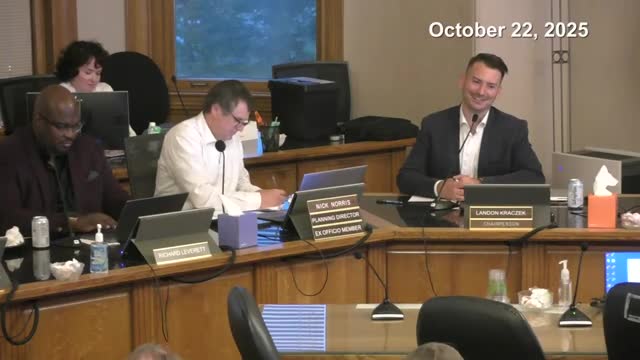Planning commission backs rezoning for Sugar House hotel; commissioners add conditions for development agreement
October 23, 2025 | Salt Lake City, Salt Lake County, Utah
This article was created by AI summarizing key points discussed. AI makes mistakes, so for full details and context, please refer to the video of the full meeting. Please report any errors so we can fix them. Report an error »

The Salt Lake City Planning Commission voted 7–1 on Oct. 8 to forward a rezoning and development agreement recommendation to City Council that would permit a proposed hotel at about 265 East 100 South in the Sugar House business district.
Staff described the request as a zoning map amendment from MU‑8 to D‑1 and a concurrent general plan consideration; the project team said the hotel would include ground‑floor commercial space, public meeting rooms and a rooftop restaurant. Staff recommended a positive recommendation to council with two conditions: a 225‑foot building height limit in the development agreement and measures to mitigate possible commercial tenant displacement.
“We are in support of the zoning map amendment with the conditions proposed by staff,” the applicant’s representative said, describing the proposal as an opportunity to add hotel inventory, ground‑floor activation and community meeting space near Sugar House Park and transit.
Public comment at the hearing was extensive and sharply divided. Supporters told the commission the site has sat vacant for years and argued locating lodging and ground‑floor retail near transit and park amenities is consistent with the Sugar House plan. Opponents, including leaders from St. Mark’s Cathedral and neighborhood groups, raised concerns about building height, construction vibration, potential damage to adjacent historic and unreinforced masonry structures, loss of light for the cathedral’s solar panels, groundwater and flood‑control impacts near the Sago Lily draw, parking, and neighborhood character.
The applicant described community benefits to be negotiated in a development agreement: discounted ground‑floor rent for a local tenant, zero‑interest tenant‑improvement financing to help local small businesses move into ground‑floor space, free meeting space for community use, paid public parking and coordination with GreenBike on a station near Sugar House Park. Staff emphasized that community benefits are captured in a development agreement that must be negotiated and signed before any rezoning becomes final.
Commissioners debated the tradeoffs between additional height and the public benefits negotiated through a development agreement. One commissioner argued that denying the rezoning would preserve the existing adopted plan designation, while other commissioners said the requested rezoning and the applicant’s benefits package merited forwarding a positive recommendation to council.
Votes: an initial motion to approve without the staff height limit failed 5–3. A subsequent motion to forward the request to council as recommended by staff (including the 225‑foot limit and the proposed development agreement items) passed 7–1.
Staff will take the commission’s recommendation to City Council, where the development agreement is expected to be negotiated and finalized; council approval and a signed development agreement are required before the rezoning becomes effective.
Staff described the request as a zoning map amendment from MU‑8 to D‑1 and a concurrent general plan consideration; the project team said the hotel would include ground‑floor commercial space, public meeting rooms and a rooftop restaurant. Staff recommended a positive recommendation to council with two conditions: a 225‑foot building height limit in the development agreement and measures to mitigate possible commercial tenant displacement.
“We are in support of the zoning map amendment with the conditions proposed by staff,” the applicant’s representative said, describing the proposal as an opportunity to add hotel inventory, ground‑floor activation and community meeting space near Sugar House Park and transit.
Public comment at the hearing was extensive and sharply divided. Supporters told the commission the site has sat vacant for years and argued locating lodging and ground‑floor retail near transit and park amenities is consistent with the Sugar House plan. Opponents, including leaders from St. Mark’s Cathedral and neighborhood groups, raised concerns about building height, construction vibration, potential damage to adjacent historic and unreinforced masonry structures, loss of light for the cathedral’s solar panels, groundwater and flood‑control impacts near the Sago Lily draw, parking, and neighborhood character.
The applicant described community benefits to be negotiated in a development agreement: discounted ground‑floor rent for a local tenant, zero‑interest tenant‑improvement financing to help local small businesses move into ground‑floor space, free meeting space for community use, paid public parking and coordination with GreenBike on a station near Sugar House Park. Staff emphasized that community benefits are captured in a development agreement that must be negotiated and signed before any rezoning becomes final.
Commissioners debated the tradeoffs between additional height and the public benefits negotiated through a development agreement. One commissioner argued that denying the rezoning would preserve the existing adopted plan designation, while other commissioners said the requested rezoning and the applicant’s benefits package merited forwarding a positive recommendation to council.
Votes: an initial motion to approve without the staff height limit failed 5–3. A subsequent motion to forward the request to council as recommended by staff (including the 225‑foot limit and the proposed development agreement items) passed 7–1.
Staff will take the commission’s recommendation to City Council, where the development agreement is expected to be negotiated and finalized; council approval and a signed development agreement are required before the rezoning becomes effective.
View the Full Meeting & All Its Details
This article offers just a summary. Unlock complete video, transcripts, and insights as a Founder Member.
✓
Watch full, unedited meeting videos
✓
Search every word spoken in unlimited transcripts
✓
AI summaries & real-time alerts (all government levels)
✓
Permanent access to expanding government content
30-day money-back guarantee


